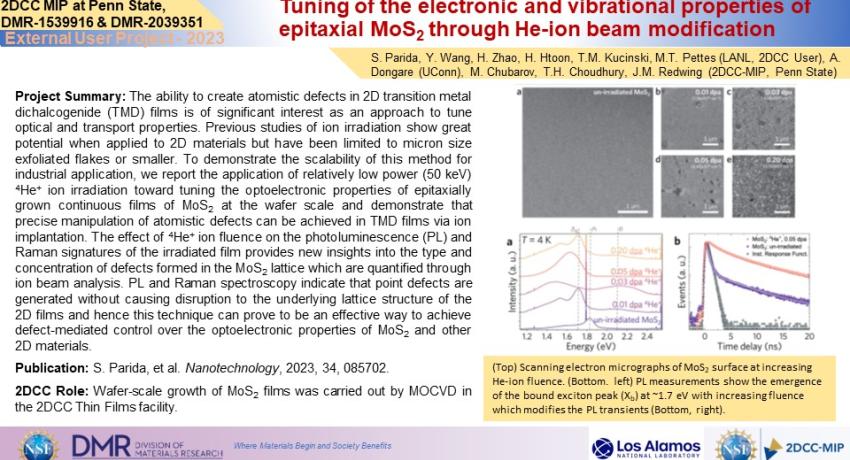Project Summary: The ability to create atomistic defects in 2D transition metal dichalcogenide (TMD) films is of significant interest as an approach to tune optical and transport properties. Previous studies of ion irradiation show great potential when applied to 2D materials but have been limited to micron size exfoliated flakes or smaller. To demonstrate the scalability of this method for industrial application, we report the application of relatively low power (50 keV) 4He+ ion irradiation toward tuning the optoelectronic properties of epitaxially grown continuous films of MoS2 at the wafer scale and demonstrate that precise manipulation of atomistic defects can be achieved in TMD films via ion implantation. The effect of 4He+ ion fluence on the photoluminescence (PL) and Raman signatures of the irradiated film provides new insights into the type and concentration of defects formed in the MoS2 lattice which are quantified through ion beam analysis. PL and Raman spectroscopy indicate that point defects are generated without causing disruption to the underlying lattice structure of the 2D films and hence this technique can prove to be an effective way to achieve defect-mediated control over the optoelectronic properties of MoS2 and other 2D materials.
Publication: S. Parida, et al. Nanotechnology, 2023, 34, 085702.
2DCC Role: Wafer-scale growth of MoS2 films was carried out by MOCVD in the 2DCC Thin Films facility.
What Has Been Achieved: A detailed study of the effects of He-ion beam irradiation on the optical and vibrational properties of wafer-scale epitaxial MoS2 monolayers.
Importance of the Achievement: The study demonstrates that the type and quantity of optically active defects in monolayer MoS2 can be tuned via ion beam irradiation with controlled fluence which is useful for quantum emitters, sensors and hydrogen evolution applications which are dependent on defects in the TMD films.
Unique Feature(s) of the MIP that Enabled this Achievement: High quality wafer-scale synthesis of TMD monolayers.
(If Applicable) Publication: Shayani Parida, Yongqiang Wang, Huan Zhao, Han Htoon, Theresa M. Kucinski, Mikhail Chubarov, Tanushree Choudhury, Joan M. Redwing, Avinash Dongare and Michael T. Pettes, “Tuning of the electronic and vibrational properties of epitaxial MoS2 through He-ion beam modification,” Nanotechnology 34 (2023) 085702. https://doi.org/10.1088/1361-6528/aca3af.
Acknowledgments: This work was supported by the Laboratory Directed Research and Development program of Los Alamos National Laboratory under project numbers 20210036DR (SP, MTP) and 20210782ER (MTP). Epitaxial synthesis of MoS2 was carried out at The Pennsylvania State University 2D Crystal Consortium—Materials Innovation Platform (2DCC-MIP) facility was supported by NSF cooperative agreements DMR-1539916 and DMR-2039351 (MC, TC, JMR). This work was performed in part at the Center for Integrated Nanotechnologies, an Office of Science User Facility operated for the U.S. Department of Energy (DOE) Office of Science. Los Alamos National Laboratory, an affirmative action equal opportunity employer, is managed by Triad National Security, LLC for the U.S. Department of Energy’s NNSA, under contract 89233218CNA000001. HH, HZ and YW acknowledge support from DOE BES award ‘Deterministic Placement and Integration Quantum Defects’.
